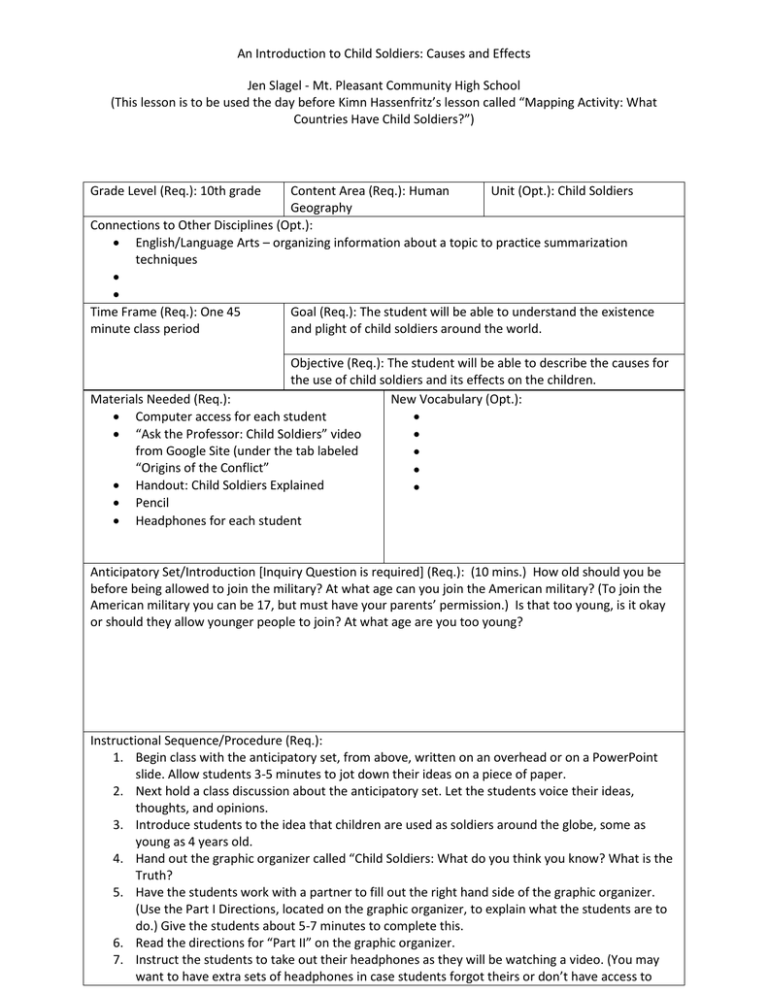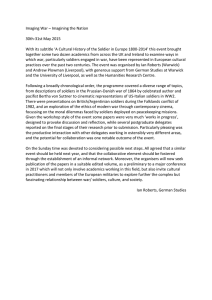An Introduction to Child Soldiers: Causes and Effects
advertisement

An Introduction to Child Soldiers: Causes and Effects Jen Slagel - Mt. Pleasant Community High School (This lesson is to be used the day before Kimn Hassenfritz’s lesson called “Mapping Activity: What Countries Have Child Soldiers?”) Grade Level (Req.): 10th grade Content Area (Req.): Human Unit (Opt.): Child Soldiers Geography Connections to Other Disciplines (Opt.): • English/Language Arts – organizing information about a topic to practice summarization techniques • • Time Frame (Req.): One 45 Goal (Req.): The student will be able to understand the existence minute class period and plight of child soldiers around the world. Objective (Req.): The student will be able to describe the causes for the use of child soldiers and its effects on the children. Materials Needed (Req.): New Vocabulary (Opt.): • Computer access for each student • • “Ask the Professor: Child Soldiers” video • from Google Site (under the tab labeled • “Origins of the Conflict” • • Handout: Child Soldiers Explained • • Pencil • Headphones for each student Anticipatory Set/Introduction [Inquiry Question is required] (Req.): (10 mins.) How old should you be before being allowed to join the military? At what age can you join the American military? (To join the American military you can be 17, but must have your parents’ permission.) Is that too young, is it okay or should they allow younger people to join? At what age are you too young? Instructional Sequence/Procedure (Req.): 1. Begin class with the anticipatory set, from above, written on an overhead or on a PowerPoint slide. Allow students 3-5 minutes to jot down their ideas on a piece of paper. 2. Next hold a class discussion about the anticipatory set. Let the students voice their ideas, thoughts, and opinions. 3. Introduce students to the idea that children are used as soldiers around the globe, some as young as 4 years old. 4. Hand out the graphic organizer called “Child Soldiers: What do you think you know? What is the Truth? 5. Have the students work with a partner to fill out the right hand side of the graphic organizer. (Use the Part I Directions, located on the graphic organizer, to explain what the students are to do.) Give the students about 5-7 minutes to complete this. 6. Read the directions for “Part II” on the graphic organizer. 7. Instruct the students to take out their headphones as they will be watching a video. (You may want to have extra sets of headphones in case students forgot theirs or don’t have access to any.) 8. Tell the students to begin the video and complete the graphic organizer as they watch. 9. Once the students have finished watching the video tell them to turn their graphic organizer over for Part III. Read through the directions with them and remind them to write in complete sentences. 10. At the end of class collect the students’ graphic organizers as these will be used as the formative assessment. 11. 12. 13. 14. 15. 16. 17. 18. 19. 20. Formative Evaluation (Req.): Completion of Assessment (Req.): Formal assessment would be graphic organizer to ensure understanding of the done at the end of the unit with a unit test or causes and effects of child soldiers. project. Iowa Core Curriculum Standards Used (Req.): • Behavioral Sciences, grade 9-12: Understand current social issues to determine how the individual is able to formulate opinions and responds to those issues. • Behavioral Sciences, grade 9-12: Understand how social status, social groups, social change, and social institutions influence individual and group behaviors. • Geography, grade 9-12: Understand how cultural factors influence the design of human communities. • History, grade 9-12: Understand the cause and effect relationships and other historical thinking skills in order to interpret events and issues. • • • • • • Common Core Curriculum Standards Used (Opt.): • Writing Standards for Literacy in History/Social Studies, Science & Technical Subjects 6-12: Write informative/explanatory texts, including the narration of historical events. a. Introduce a topic and organize ideas, concepts, and information to make important connections and distinctions. • • • • NGS Standards Used (Req.): • Standard 13: How the forces of cooperation and conflict among people influence the division and control of Earth’s surface. • Standard 18: How to apply geography to interpret the present and plan for the future. • • • • • • • • Five Themes of Geography Used (Req.): • Regions • Movement • Human/Environment Interaction • Place • 21st Century Universal Constructs (Opt.): School District Standards and Benchmarks (Opt.): • • • Other Disciplinary Standards (Opt.): • • • • • Other Essential Information (Opt.): Other Resources (Opt.): • https://sites.google.com/a/mtpcsd.org/gai-conflict-human-rights/ • • • Child Soldiers: What do you think you know? What’s the truth? Directions: Part I: Today you will be learning about the causes and effects of countries around the world using child soldiers. Before we discuss the facts I want to know what you know about child soldiers. With a partner please fill out the left hand column of this graphic organizer based on what you already know about child soldiers. (I know you won’t know all the answers, but jot down your ideas.) Directions: Part II: Log on to the following website https://sites.google.com/a/mtpcsd.org/gai-conflict-human-rights/ . Once on the site you should see a menu on the left hand side of the screen. Click on “Origin of Conflict.” Play the video titled “Ask the Professor: Child Soldiers” and complete the right hand side of this graphic organizer as you watch the video. (You may have to stop the video from time to time to give yourself time to write.) What do you think you know about child soldiers? Based on the video, what is the truth about child soldiers? What is a child soldier? (Give me a definition) Why do children become soldiers? How many child soldiers are there in the world? Why are children chosen to be soldiers? How are children recruited to be soldiers? Once children become soldiers what are their jobs? What are the effects on children? What can we do to prevent the use of child soldiers? Directions: Part III: Write 3 statements explaining your overall impression/reaction about the use of child soldiers after watching this video. (For example, was anything shocking or surprising? Did anything make you angry?) #1:_______________________________________________________________________________________________________________________ #2:_______________________________________________________________________________________________________________________ #3:_______________________________________________________________________________________________________________________ Write 3 summary statements about what you learned about child soldiers based on the video. (For example, what are the 3 most important facts about child soldiers that you learned in your own words.) #1:_______________________________________________________________________________________________________________________ #2:_______________________________________________________________________________________________________________________ #3:_______________________________________________________________________________________________________________________ Cross-Curricular Connection: Kimn Hassenfritz and I have worked collaboratively to create the first two lessons in a unit on child labor and child soldiers around the globe. The lessons are intended to be used together, one right after the other. These two lessons will be utilized in the next academic year in a new course to be taught called Human Geography. This lesson is cross-curricular in that it uses some of the skills that are practiced in the English/Language Arts classroom. Those skills include listening, taking notes, organizing those notes on a graphic organizer, and summarizing the information learned. I believe there are a couple of ways this curriculum could be used in the English/Language Arts classes. One of the ways I think this could be used in the English department at Mt. Pleasant High School is when the students are required to write persuasive essays. The students could write persuasive essays about the ban of child soldiers and the consequences for countries found to be using children as soldiers. Another way this topic could be used is by having students evaluate the arguments for and against the use of child soldiers around the globe. Then the students could be asked to write a position paper on which argument they agree with and why. These are just a couple of ways I think this curriculum could be used in the English department at Mt. Pleasant Community High School.



